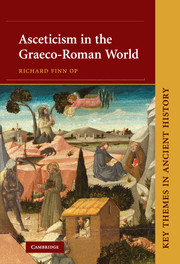Book contents
5 - Cavemen, cenobites, and clerics
Published online by Cambridge University Press: 22 January 2010
Summary
Theodoret (b. c. 393), bishop of Cyrrhus from 423 to 446, looked back on a childhood in Antioch during which he was taken by his mother to be blessed by the renowned Persian monk Aphraate and sent each week to be blessed by another monk, Peter, who inhabited a tomb outside the city. His visits testify to the reputation monks could win for protecting Christians from the evils to which they believed themselves exposed. A monk could be recognized as a holy man through whom the saving power of God was manifested. Peter made a belt for Theodoret from his own, which was then used to heal the child, and others, of sickness. These connections with individuals and families in the cities from which the monks only partially distanced themselves, partly explain the value and thus the rise of much monastic life which emerged in the course of the fourth century. They also point to its variety.
Aphraate and Peter do not obviously belong in the Origenist tradition charted in the last chapter; nor were they the only monks around Antioch with its large Christian population. By ad 386 a ‘black-robed tribe’ of ‘cave-dwellers’ had incurred the deep hostility of Libanius (314c. 393), the pagan teacher of rhetoric, who decried their attacks on rural shrines, and their appearance each summer in the city. Already, in the late 369s, the young Chrysostom had persuaded two friends to join in him in learning the ascetic life from Carterius and Diodore, the heads of local monastic communities (askētēria).
- Type
- Chapter
- Information
- Asceticism in the Graeco-Roman World , pp. 131 - 155Publisher: Cambridge University PressPrint publication year: 2009

